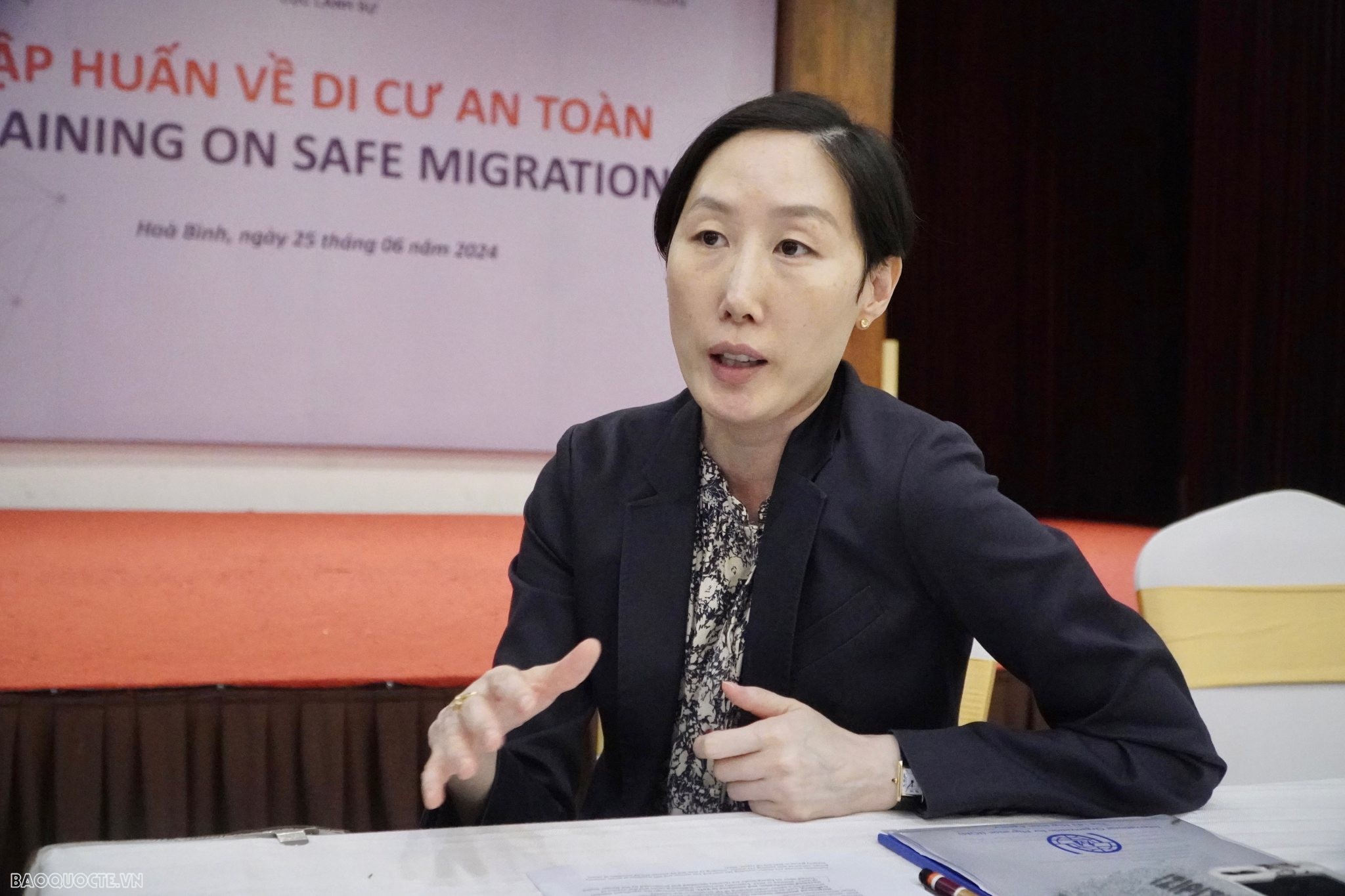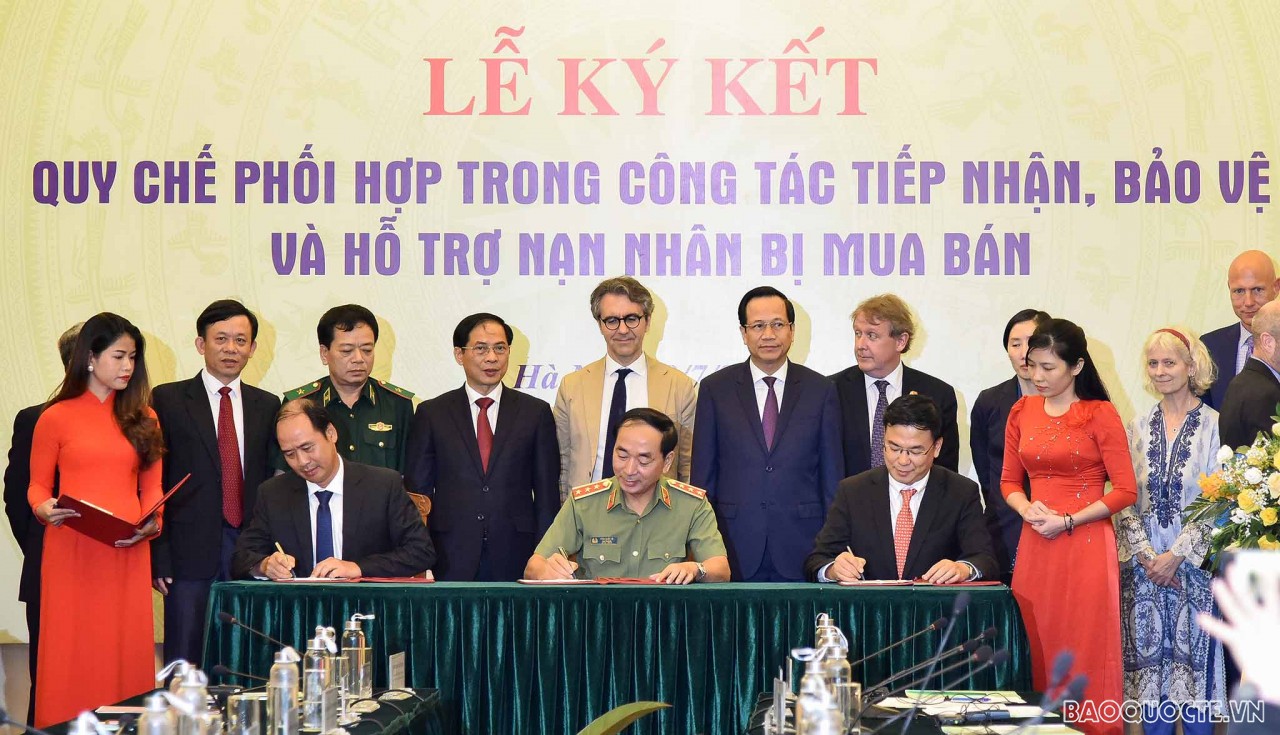
IOM Chief of Mission: Vietnam has been very active on promoting safe migration
Latest
 |
| IOM Chief of Mission in Vietnam Park Mi-Hyung. (Photo: Tuan Viet) |
On June 25, in Hoa Binh, talking with The World & Viet Nam Report on the sidelines of the training on safe migration, Ms Park Mi-Hyung, Chief of Mission of the International Organisation for Migration (IOM) in Vietnam, highly appreciates Vietnam's efforts to promote safe migration and against human trafficking.
Could you touch on emerging trends in international migration with focus on Vietnam related priorities?
Labour migration is a defining feature of global economy and is a powerful driver for development, well-being and growth. When migrants fully access their rights, they can truly unlock their potential and harness the full power of labour migration.
The Asia region has long been a major hub for labour migration. The region hosts 14% of the global stock of migrant workers.
Global demographic shifts, economic transformations and climate change will be the key drivers of migration in Asia in the next decade. South-East Asia is one of the most disaster-prone subregions in the world, with millions of displacements occurring each year. In the near future, it will be an issue that we all need to address.
Data shows that migrant workers are contributing to economically vital sectors including agriculture, construction, manufacturing, and domestic work.
The benefits of labour migration are well documented. In countries of destination, labour migration helps address the labour and skills shortages. In countries of origin, migrant workers contribute to improving the lives of families and communities through the transfer of skills and financial resources, while alleviating pressure on domestic labour markets. In 2023, Vietnam continues to stand as one of the top 10 recipients of overseas remittances worldwide, with an estimated 14 billion USD, according to the World Bank.
But it is important to highlight some risks throughout the labour migration journey: lack of transparent information, lack of clear employment contracts or contract substitution, inadequate accommodation, non payment or underpayment of wages, lack of access to remedy.
This exacerbates risk of various forms of human and labour rights violations at all stages of the labour migration journey.
That’s why IOM is working closely with both the government of origin and destination countries, international partners, civil societies, as well as the private sector to uphold human rights, conduct business responsibly and foster a greater expansion of regular migration pathways. Not just any pathway, but safe, regular, quality pathways where people enjoy their full human and labour rights.
How do you feel about Vietnam's efforts to facilitate “safe migration that benefits all” and increased effort to tackle human trafficking?
In the last few years, Vietnam has been very active on promoting safe migration as well as making serious efforts against human trafficking.
One example is the implementation of the National Human Trafficking Prevention and Control Programme for 2021-2025, with a vision for 2030, which includes new solutions and tasks to prevent and fight human trafficking in all areas. Other achievements include:
Heightened attention towards the investigation and identification of various forms of trafficking, such as domestic trafficking, forced labour; more disaggregated data on Trafficking in Persons (TIP) provided for a better understanding of TIP situation in the country.
Increased identification and assistance to Victims of Trafficking (VoTs), shown through the significant number of VoTs assisted in 2022. Especially the human trafficking cases and the victims of forced labor on fishing boats are recently identified and prosecuted by the Border Guard.
Law on Contract-Based Vietnamese Overseas Workers (or Law 69), effective from 1st January 2022, a step closer to ensuring fair ethical recruitment practices.
The Vietnamese Government has also dedicated to streamline inter-agency coordination and referrals through standardized procedures. One such example is the initiative undertaken by the MOLISA, which enabled the Inter-ministerial Coordination Regulation on Reception, Protection, and Support for Trafficked Victims that came into force in August 2022, applicable to the four Line Ministries of MFA, MPS, MOLISA, and MND.
 |
| Overview the training on safe migration in Hoa Binh on June 25. (Photo: Tuan Viet) |
Please tell us about the risks of fraudulent recruitment for labour exploitation abroad? In your opinion, what do we need to do to prevent this risks?
Although the benefits of migration are well-documented, migrant workers remain at risk of various forms of human and labour rights violations at all stages of the labour migration journey. Migrant workers often pay exorbitant recruitment fees which can make them vulnerable to debt bondage, exploitation or forced labor. But it is important to highlight other risks throughout the labour migration journey: lack of transparent information, lack of clear employment contracts or contract substitution, inadequate accommodation, discriminatory selection process and requirements, such as pregnancy tests.
According to the latest Modern Slavery Estimates, by ILO, IOM and Walk Free, migrant workers are three times as likely than local workers to experience instances of forced labour. While often migrant worker vulnerability is structurally supported, it is the private sector that is accountable for 85% of exploitation. At the same time, labour migration governance gaps exist as governments in the region strive to implement the principles of the Global Compact on Safe, Orderly and Regular Migration (GCM) in line with the relevant Sustainable Development Goals.
Existing regular labour migration pathways fail to accommodate the overall demand for migrant workers in countries of destination and the need for gainful opportunities for workers from countries of origin. This results in high proportions of irregular labour migration and the presence of large undocumented populations in countries of destination with increased risks of exploitation.
Despite some progress over time, gaps in existing laws and regulations in the region tend to exacerbate the vulnerabilities of migrant workers. In countries of origin, effective regulation of recruitment remains a challenge as migrant workers can legally be charged recruitment fees and related costs, weak pre-departure orientation systems and lack of oversight of labour recruiters, lack of effective penalties and sanctions. In destination countries, migrant workers’ fundamental rights to changing employers and freedom of association are restricted.
To tackle those issues, in every programme, IOM supports states to expand and improve regular labour migration pathways, including policies, legislative, regulatory frameworks and implementation mechanisms. IOM takes a “whole-of-government” approach, working across relevant ministries and departments as well as at the national, subnational and local levels. We also put effort into raising awareness of safe migration, including skills development, job matching, promoting knowledge on human trafficking prevention, providing pre-departure information on health issues and raising awareness of Law 69 so everybody knows their rights, reducing the risk of labour exploitation.
When talking about ensuring labour rights, we cannot leave the business out of the picture. That’s why we also have a regional programme to develop strategic partnerships and projects with industry associations, multinational enterprises, employers, labour recruiters to strengthen corporate respect of migrant’s rights and implement innovative solutions to promote ethical recruitment and responsible employment, increase supply chain transparency, conduct human rights due diligence, and provide effective and quality operational grievance mechanisms and remediation.
 |
| Representative leaders of Ministries signed Regulations on coordination in receiving, protecting and supporting victims of trafficking on July 18, 2022. (Photo: Nguyen Hong) |
What are some of the highlights among the projects IOM implements in Vietnam to protect migrants?
First is data. Effectively addressing human trafficking requires up-to-date and reliable data to empirically ground policy, programme, and support for the victims. IOM is supporting the MPS to further develop TIP database, and currently rolling out a nation-wide training to collect TIP data. We remain committed to this process.
Human trafficking is a complex issue, and it evolves quickly. That’s why the counter trafficking community must evolve and understand the many faces of trafficking in persons. It is crucial to find innovative way to identify emerging trends, especially crimes happen in cyber space; provide comprehensive support to the victims and seeks timely and viable solution to meet the new evolving challenges of human trafficking.
Second is awareness raising: In the last few years, through our Prevention campaign, we have reached out to nearly 1.8 million people (August 2022 – March 2024) both online and offline, among them, many are youths. We have a popular fanpage named Think Before You Go, where we promote safe migration information among the youths and aspirant migrants, with more than 12,000 active followers.
By strategically integrating TIP and safe migration content into school extracurricular activities, we aim to reach every student with education on trafficking risks, emphasizing the potential for large-scale impact. This approach is sustainable as it leverages the universal access to education, ensuring that every young individual learns about TIP prevention, fostering a culture of empathy and responsibility across society. It is very encouraging to see that the National Assembly yesterday was discussing the potential of integrating TIP into school curriculum. It shows that IOM’s approach is aligned with the Government of Vietnam.
Additionally, through our outreach activities, we encourage youth to actively engage in shaping migration discourse within their communities, empowering them to become future changemakers. We launched that initiative earlier this year and got an overwhelming of more than 600 youths to submit their applications. We finally support 06 initiatives by providing seed funding, amplifying their impact and contributing to a safer future for all.
Third, strengthening capacity to protect and prosecute. IOM is working closely with Vietnam to improve standardized tools in victim screening and verification. Together with MOLISA and other partners, we have also been developing standardized screening forms for frontline officers to detect, screen, refer and identify victims of trafficking in business and service establishments which are prone to social vices.
Last is partnerships. More cooperation with civil societies is needed, because groups that are close to the most affected groups who can reach the most vulnerable populations.
We have a network of more than 40 private sector partnership to adopt responsible business practices and supply change transparency to prevent any inadvertent involvement of human trafficking in the region. IOM also proactively collaborate with technology companies and experts to detect traffickers’ evolved tactics, and come up with innovative solutions to tackle the issue.
Thank you!

















